Before we dive into exactly what a webinar funnel is, we need some introduction to B2B marketing and why webinars are important.
Though they’re only one letter apart, B2B and B2C marketing are nevertheless very different. B2C marketing usually involves winning over only one shopper, often quite quickly. With B2B marketing, there are multiple stakeholders to woo, mostly with prolonged decision-making processes to take into account.
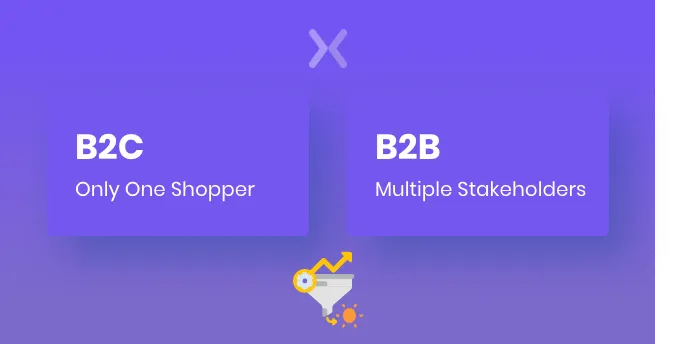
At every step of the sales funnel, B2B marketers need to convince buyers of the value of their service. That could be a junior team member, tasked with comparing a list of service providers. It could be a team leader looking for solutions that would impress their boss. Or it could be a senior executive, looking for a way to maximise their ROI. Each will have their own goals and needs, and each will need a slightly different approach.
Thanks to these complexities, B2B marketers often employ a wide variety of techniques and methods, passing leads through the sales funnel until they reach a point of sales-readiness.
One of the most effective forms of marketing for the B2B sector is webinars, as they can be tailored to different stakeholders, and they allow B2B marketers to cast a wider net. According to research from Demand Wave, many marketers find webinar funnels to be the second-best revenue-driver and lead generator.
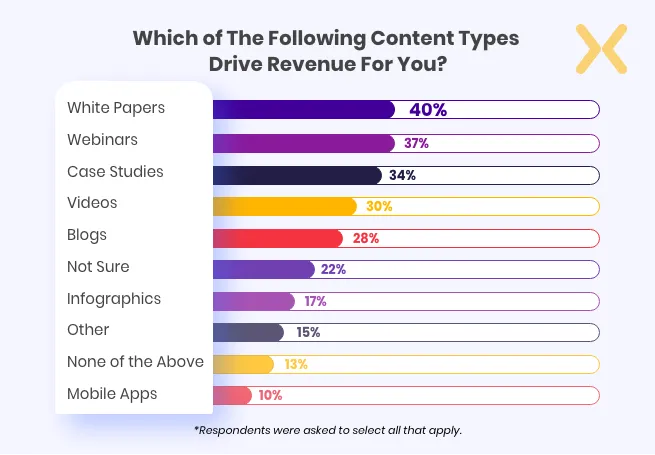
Unlike some other marketing techniques, webinars also offer value to the leads themselves in the form of useful knowledge and content, while still helping to move them through the webinar sales funnel.
With a proper strategy, you can create a reliable webinar funnel that can educate potential buyers, as well as show them how your business can cater to their needs.
In the most simple terms, a webinar funnel is the marketing process and technology used to attract potential viewers to your webinar.
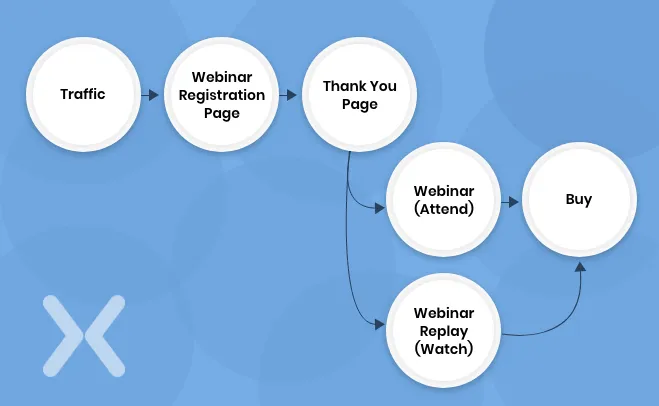
The first step in a perfect webinar funnel is to create a landing page and make sure it’s optimized correctly. As a quick recap, a landing page is a place a visitor lands when they click on a link in one of your emails or ads. In digital marketing, however, a landing page is more specifically a standalone page on your website, designed to achieve a specific goal. They are campaign-specific pages with a single call to action and no website navigation.
Also called lead capture pages, the most common goal of a landing page is to convert visitors by encouraging them to fill in a form. Unlike a regular webpage, which encourages exploration, a landing page is designed to “nudge people into the funnel” by giving them two options - fill in a form, or click away. This makes landing pages the easiest and most effective way to generate leads.
When it comes to webinar landing pages specifically, there are a few elements to optimise:
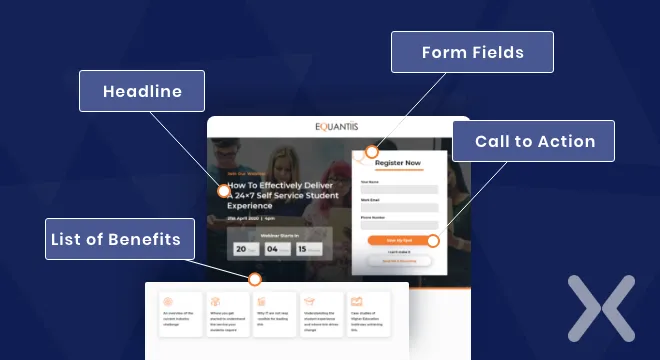
Headline: Your landing page headline should immediately grab attention by being both clear and compelling. If you’re making use of PPC ads in your webinar funnel, you should also make sure the headline matches what users see in your ad.
List of Benefits: Highlight exactly what a potential participant will gain by registering for your webinar. You have to convince them to give you their contact details, as well as take the time to attend the webinar. Make sure your copy is convincing.
Call to Action: Your CTA should be one of the first things a user sees when they land on your page. Make sure yours stands out.
Form Fields: Though it can be tempting to ask for all the information you might want upfront, you can increase conversions by keeping required form fields to a minimum. Start with their name and email address. Later, you can progressively ask for more information.
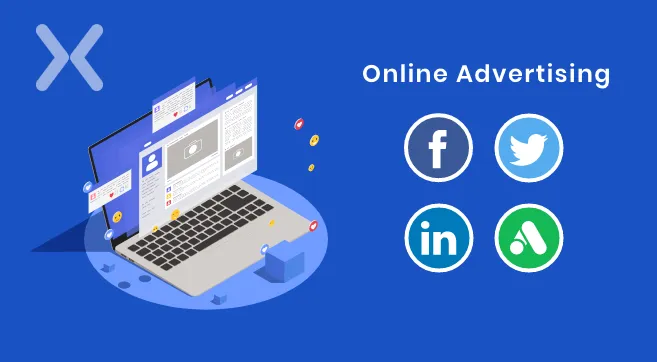
Once you’ve created a well-optimised landing page with compelling copy and visuals, the next step in the webinar funnel is to promote your webinar. You probably don’t need to be told to post about your webinar on all your social platforms. Facebook, Twitter and LinkedIn especially are good for B2B markets.
Other than that, you can expand your reach by making use of online advertising and move potential visitors down the webinar funnel. You can also make a virtual business card and have a link to your webinar in it & share it with the prospects. Both Facebook Ads and Google AdWords are incredibly useful marketing tools. Both platforms can help you to generate more leads and extend your brand presence. Each also offers highly-detailed demographic targeting, ensuring your message is seen by the right people.
With Google AdWords, you can access the power of intent marketing. Your ad is shown to people when they are searching specifically for keywords related to your campaign. As such, they will see your ad copy when they are searching for your webinar topic.
Your ads could achieve an average CTR of around 2% include, but by following AdWords best practices, that could be much higher. Some of those best practices include:
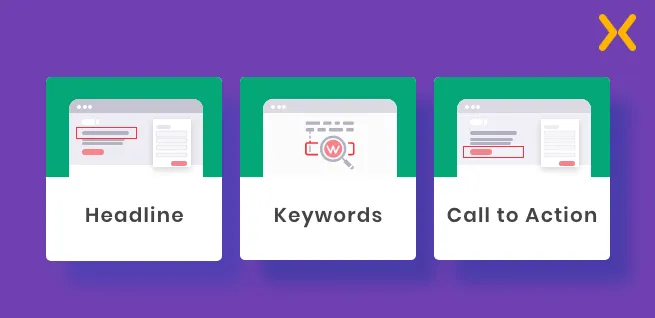
Headline: The first step to optimising the headlines on your landing page is to ensure that your ad copy matches what visitors see on your landing page. If your PPC ads convey a different message to what they then see on your landing page, they may feel as though they have been misled, causing them to click away and not take any action, which will reduce your conversion rate.
Keywords: Make sure to use your webinar topic and any derivatives as a keyword. Also make sure only to use one or two targeting methods, e.g. keywords, audiences or remarketing.
Call to Action: The call to action (CTA) is one of the most important aspects of your landing page, and there are multiple ways to optimise them.
Move the CTA to a different location on the page.
Experiment with the number of CTAs on the page.
When using long-form landing pages, make sure to use multiple CTAs throughout the copy.
Change the copy and colour of your CTAs.
Increase button size.
Facebook Ads offers hyper-targeting, allowing you to market your webinar to specific demographics. You could show your ad to people who work in marketing, or who like specific pages, such as those of your competitors, making a way to get them into your webinar funnel. Facebook Ads have a decent conversion rate and are great for increasing brand awareness.
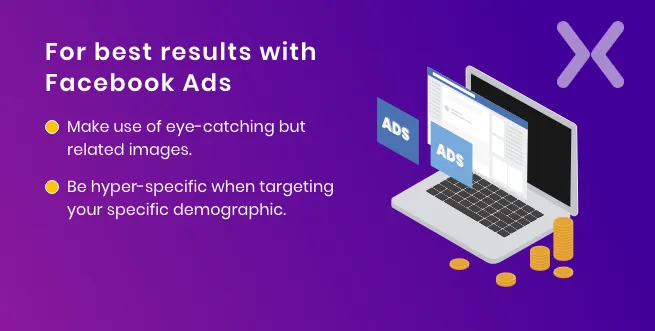
For best results with Facebook Ads:
Make use of eye-catching but related images. The colours and visuals are going to be the first thing a user sees when they see your Facebook ad for a webinar funnel. Make use of contrasting colours and related imagery to ensure you grab their attention.
Be hyper-specific when targeting your specific demographic. Facebook Ads has some of the most powerful targeting available. With incredible rich demographic data available, such as Interests, Custom Audiences, and Lookalike Audiences, you can target exactly who you’re looking for.
There is some debate as to whether Facebook Ads can be successful for B2Bs, as it tends to perform better for B2C retailers. Your success on the platform will depend on your demographic. If your webinar funnel is aimed at anyone in online marketing, such as social media managers, content marketers or digital advertisers, you’ll probably have a lot of luck on Facebook.
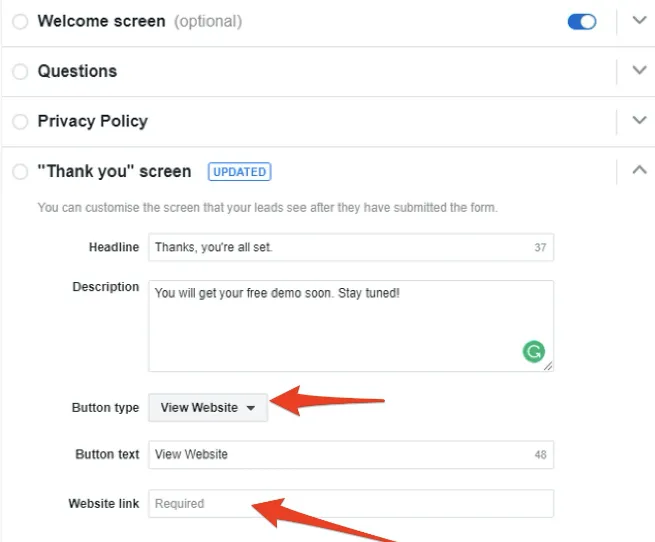
You could also use Facebook Lead Ads and get signups directly from users within Facebook. In this scenario, Facebook users do not visit the webinar registration sign up landing page, instead sign up as they are logged in Facebook. However, you can improve their experience by having a Call to Action post sign up. You can add a call to action button like “Book a Demo” and link it to your landing page to nudge them to the next stage in your facebook funnel. In case of a webinar sign up, you can show more details about the webinar e.g. participants, topics covered, date/time in different timezones etc.
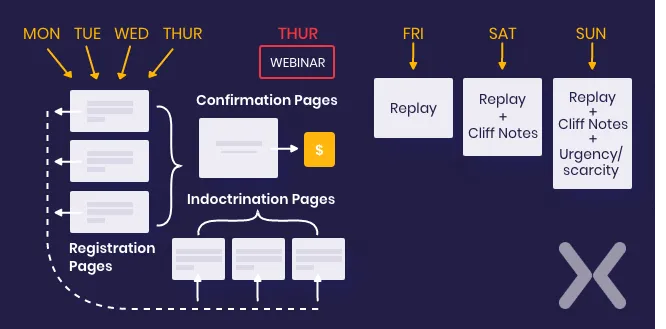
Getting someone to sign up for your webinar is only the first step. Afterwards, your next objective is to ensure that they attend. Even for free webinars, the drop-off rate can be rather steep.
One way to move users through the webinar funnel is an email marketing automation campaign. With email automation, you can send an email immediately after a user converts, triggering a sequence of emails designed to increase webinar attendance.
With just a few simple emails, you could dramatically increase your webinar attendance, and begin to build lasting relationships. Your webinar funnel email sequence should be between three and five emails, but don’t bombard them with all five and all your information at once.
An example pre-webinar email sequence could look something like this:
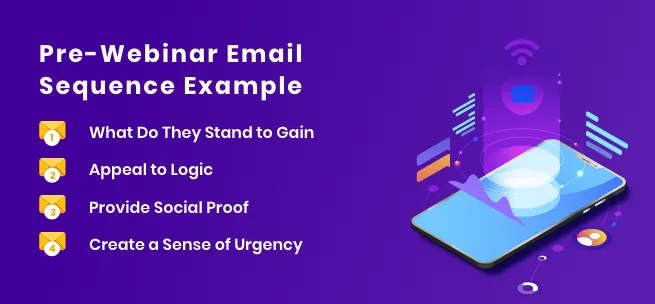
Email One - What Do They Stand to Gain
In your first email, you can thank the prospect for registering, and begin reminding them of the benefits of attending your webinar. You want to show them that you are able to provide valuable knowledge. You can:
Explain what they can expect to gain from your webinar.
List the subjects you’ll be covering.
Include links to other relevant content on the topic.
Remind them of how the webinar could help them to solve a problem.
Email Two - Appeal to Logic
In the second email a few days later, focus on the problems you’ll be helping them solve with your webinar. Explain why it’s important that your prospects hear what you have to say. Address the questions they may have, and let them know you’ll be answering them with your webinar. You can cover:
The challenges they’re probably experiencing.
Reason on why they should listen to you.
Reiterate the topics you’ll be covering with your webinar.
Email Three - Provide Social Proof
The third email is all about handling objections and building trust. Your prospect has likely never heard of you or your business before so that you can include:
Testimonials from clients or people who have attended previous webinars
Case studies
Mentions of any awards or qualifications you’ve received, or publications you’ve been in
Social proof shows that you are a credible source of information, and proves to prospects that they should trust you.
Email Four - Create a Sense of Urgency
Your next email should be sent a day before the event, reminding them that the webinar is happening soon. You can also include any information they need before attending, such as any software they need to download.
You can also send out a final email an hour before the webinar, letting them know it will be starting soon. Remind them to click the link 10 minutes before the webinar starts.
Just because someone has attended your webinar doesn’t mean the relationship-building is over. Ideally, you want that attendee to become a customer. You can follow the same sequence as mentioned above - Personal Gain, Logic, Social Proof and Fear - to create a post-webinar funnel email sequence designed to build on-going relationships
Similar to the pre-webinar sequence, you don’t want to bombard your prospects with too much information at once. Space the emails out by a few days, and create urgency by limiting the replay availability of your webinar.
You can also use segmentation to send different emails in your webinar funnel to those who attended and those who didn’t.
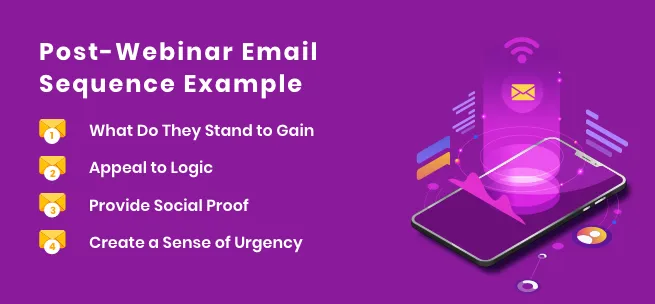
While your brand and webinar is fresh in their minds it is the perfect time to move prospects along the webinar sales funnel.
For those who attended: Thank them for visiting, and let them know the replay is available if they want to recap. Highlight again some of the benefits of watching the webinar, and reiterate some of the challenges and pains your webinar could solve.
For those who didn’t: Let them know you’re sorry they couldn’t attend. Remind them of the benefits and let them see the replay link will be available for a limited time.
You can also include a link to a free trial or VIP demo of your product or service in your webinar funnel email sequence to encourage them to take the next step.
In your next webinar email sequence, you can remind them again of the topics you covered in your webinar and remind them that the replay is still available. You can also include a transcript, and encourage them to share the recording.
You can also include links to additional content, statistics and case studies.
After your webinar, you will have more social proof, especially for those who didn’t attend the webinar itself. You can include testimonials and screenshots of the webinar itself and what attendees said. Include another link to the webinar replay, and remind them that it will only be available for a limited time. Address any objections they may have to watch the replay
In your last email, give them one final reminder that the replay will only be available for a limited time. Reiterate the benefits of watching the webinar, and remind them that if they don’t act soon, they won’t be able to watch it at all.
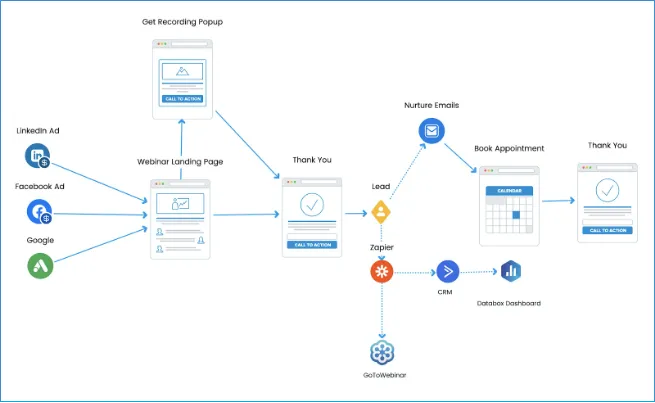
You can also come up with One-time-offers (OTOs) for your webinar participants only. These offers could lure your new leads to take the next step. Here are some ideas for OTOs:
Book a consult
Book a free audit of 15-min
Take a Quiz and get instant results
Special Pricing
Satisfaction Guarantee
Performance Guarantee
Webinars are great marketing tools for B2B businesses, but the work doesn’t stop when the webinar is over. With a well-designed webinar funnel, you can increase not only webinar attendance, but sales as well.
The last thing you want is to host a webinar which no one attends or bring in a bunch of leads who don’t convert later on. To avoid those situations, you need to build a proper webinar funnel. Though it’s not rocket science, it is a science. Don’t just throw a webinar together and hope the leads will come. Think about how you can most effectively guide leads from thinking about attending your webinar to eventually making a purchase.
With the tips we’ve provided, you should be able to create a webinar funnel that converts. If you need more help, you can check out our 5-day Webinar Email Course, which offers content ideas, checklists, comparison sheets, guides and more, showing you how to set up and plan your webinar to generate leads.
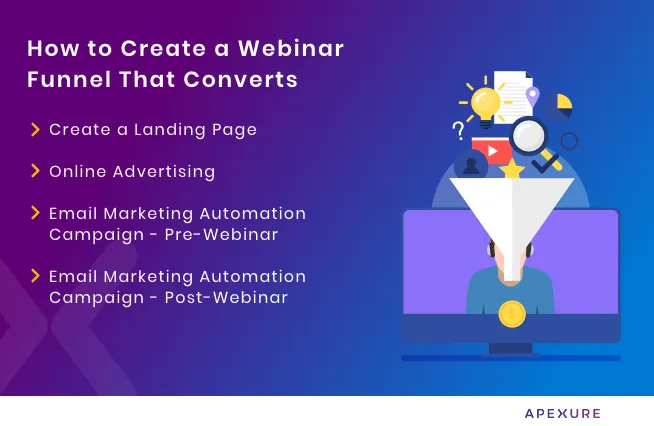
Drive More Sales or Leads With Conversion Focused Websites and Landing Pages
Get Started.webp)
In today’s fast-paced digital world, having a responsive website is no longer just a nice-to-have, it’s essential. Whether...
As artificial intelligence continues to evolve, businesses are finding innovative ways to enhance their marketing efforts. One of...
Get quality posts covering insights into Conversion Rate Optimisation, Landing Pages and great design